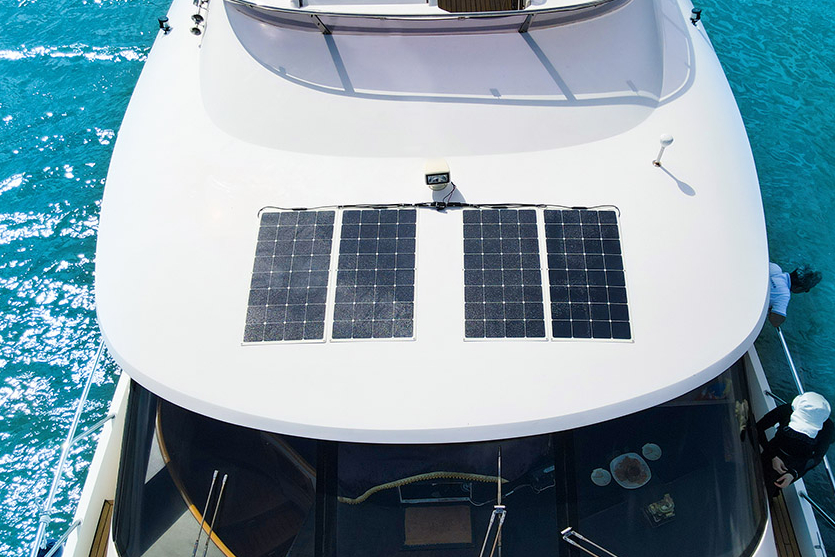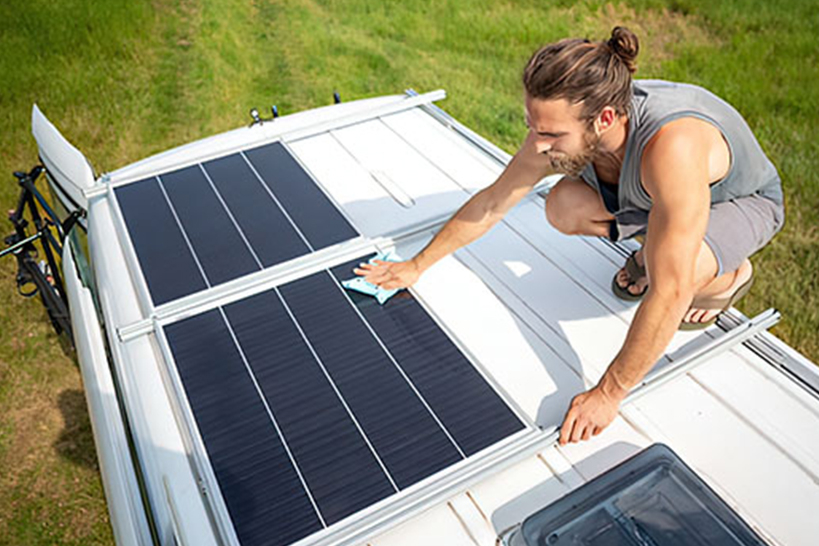A semi-flexible solar panel, also known as a semi-flexible solar module or panel, is a type of photovoltaic (PV) module designed to be lightweight, thin, and, as the name suggests, somewhat flexible. Unlike traditional rigid solar panels, which are typically made of glass and aluminum frames, semi-flexible solar panels are made using advanced materials that allow them to bend to some extent.
What do we know about the semi flexible solar panel?
Semi-flexible solar panels are a type of solar panel that has a more flexible back sheet. This allows the panel to deform more when it’s tilted in the sun, which leads to more efficient use of sunlight.
- Lightweight and thin: They are much lighter and thinner than traditional rigid solar panels, making them suitable for applications where weight and space are constraints.
- Bendable: These panels can bend slightly, allowing them to conform to certain curved surfaces. However, they are not as flexible as truly flexible solar panels, which are usually made with specialized materials like thin-film technologies.
- Durable: Despite their flexibility, semi-flexible solar panels are designed to be durable and resistant to environmental factors such as impact, moisture, and temperature variations.
- Portable: Due to their lightweight and flexible nature, they are ideal for portable and on-the-go applications, like camping, hiking, marine use, or other situations where traditional rigid panels would be impractical.
- Installation: Semi-flexible solar panels can be affixed using adhesives or mounting options that do not require drilling, which can be advantageous for certain applications or surfaces.
- Efficiency: Semi-flexible solar panels typically have slightly lower efficiency compared to traditional rigid panels, primarily because they use different materials and manufacturing processes.
How do semi flexible solar panels work?
Semi-flexible solar panels work on the same fundamental principles as traditional rigid solar panels. They harness the photovoltaic effect to convert sunlight into electricity. Here’s how they work:
- Photovoltaic Effect: The core component of a semi-flexible solar panel is the photovoltaic (PV) cell. PV cells are made of semiconductor materials, most commonly crystalline silicon. When sunlight (photons) strikes the surface of the PV cell, it excites the electrons in the semiconductor, causing them to be set into motion.
- Electron Flow: The excited electrons are directed to flow through an electric circuit within the solar panel. This flow of electrons creates an electric current. The flow of electrons is unidirectional due to the way the solar cells are interconnected within the panel.
- Current Collection: Within the semi-flexible solar panel, there are multiple interconnected PV cells that collectively produce electricity. These cells are wired in a series or parallel configuration to generate the desired voltage and current levels.
- Encapsulation: To protect PV cells and electrical connections from environmental elements like moisture and dust, semi-flexible solar panels are encapsulated with specialized materials that provide a degree of flexibility and durability.
- Substrate and Backsheet: Semi-flexible solar panels usually have a flexible polymer substrate, which provides the panel’s flexibility. This is often combined with a protective backsheet, designed to protect the solar cells from the backside.
- Encapsulation Layer: Above the solar cells and backsheet, there is an encapsulation layer, which is typically made of materials like ethylene-vinyl acetate (EVA) or similar materials. This layer bonds the solar cells and other components together while providing protection against mechanical stress.
- Contacts and Wiring: Electrical contacts are attached to the solar cells to collect the generated electricity. These contacts are connected to wiring that routes the electricity to the panel’s junction box, where it can be either used immediately or sent to a battery for storage.
When sunlight strikes the surface of the semi-flexible solar panel, the PV cells start generating electricity, and the generated electrical energy is then available for use or storage. The amount of electricity produced depends on factors like the intensity of sunlight, the angle of incidence, the efficiency of the solar cells, and the size of the panel.
It’s important to note that while semi-flexible solar panels offer certain advantages in terms of portability and installation options, they may have slightly lower efficiency compared to traditional rigid panels due to the materials used and manufacturing processes. As with any solar panel, their performance is influenced by factors such as shading, temperature, and orientation to the sun.
If you’re struggling with which supplier to choose, then I recommend Sungold. Founded in 2008, Sungold Solar Co., Ltd. has always developed high-performance products that can cope with harsh environments. They are the first to develop flexible products that can cope with outdoor camping portable equipment. I believe you will find the right product with them!
Conclusion
If you’re looking for a flexible solar panel that can be easily attached to your roof, then a semi-flexible solar panel might be the right choice. Semi-flexible solar panels are made of thin plastic and metal sheets that allow them to bend in some directions. This makes them ideal for attaching to roofs where there is limited space or where it is difficult to fit a standard rigid solar panel. They also have the advantage of tracking the sun throughout the day, which means they will generate more power than a standard rigid solar panel over an entire day. If you have any questions, pls feel free to contact us!













